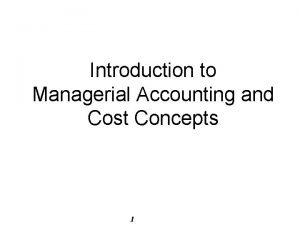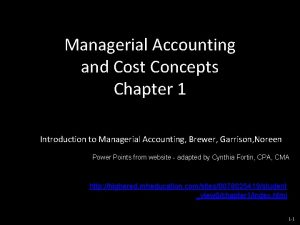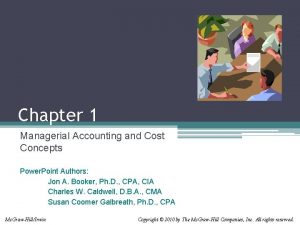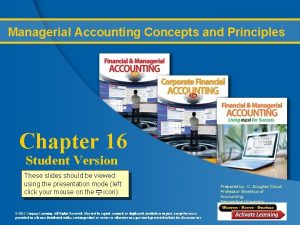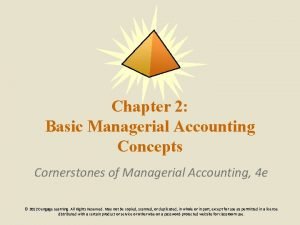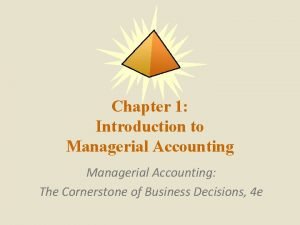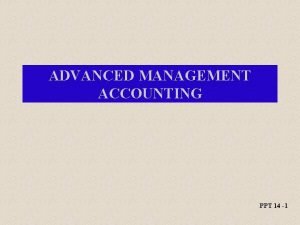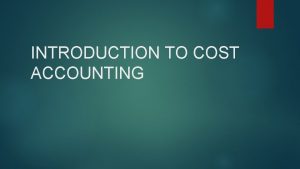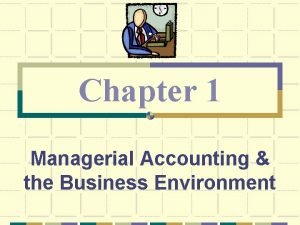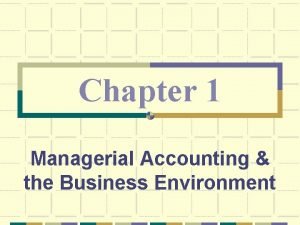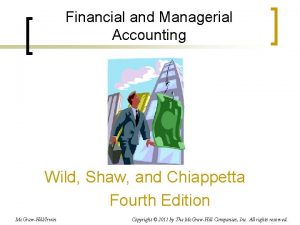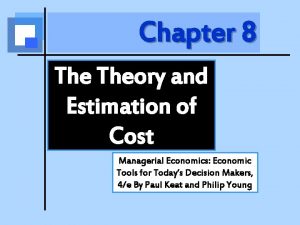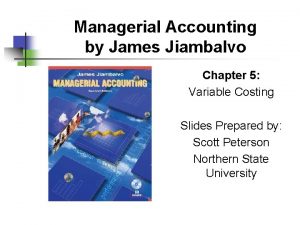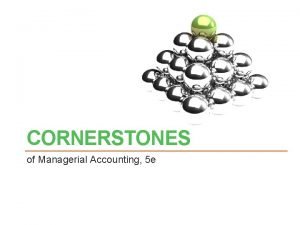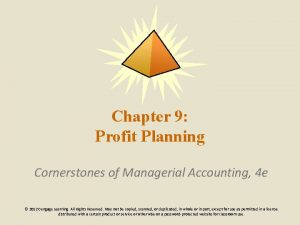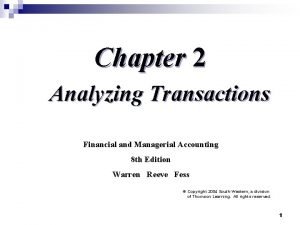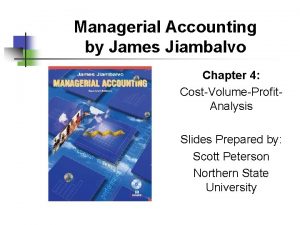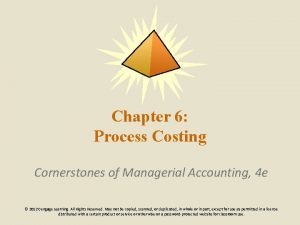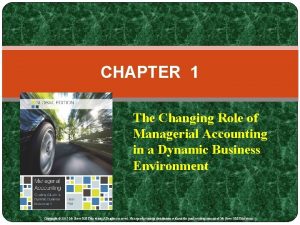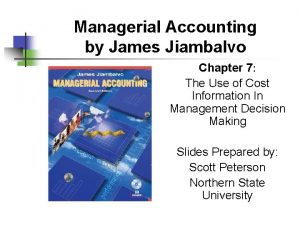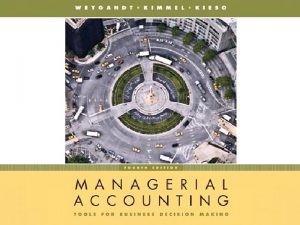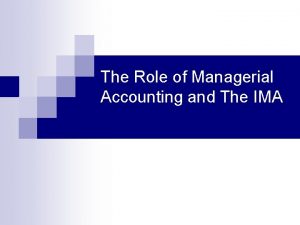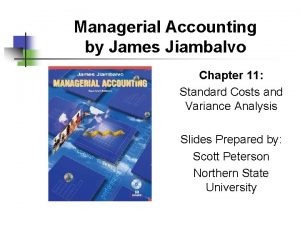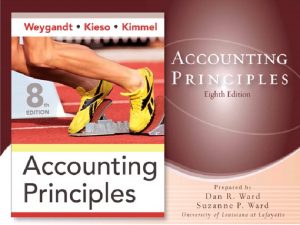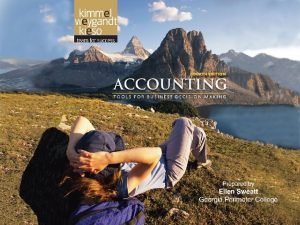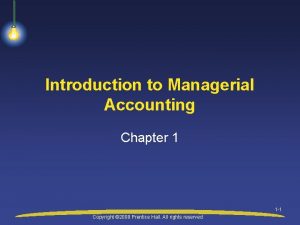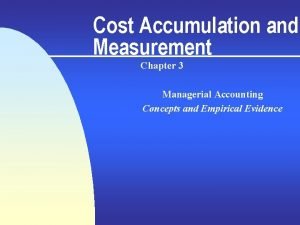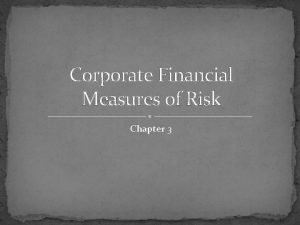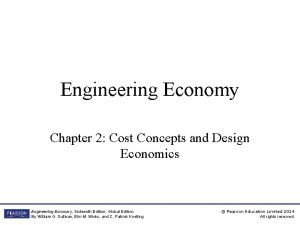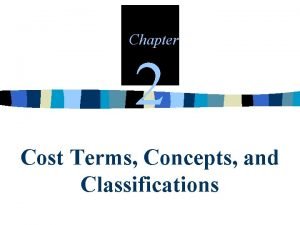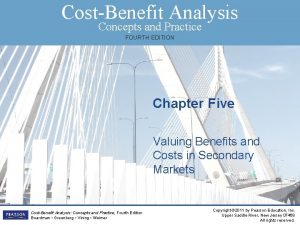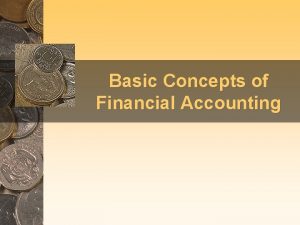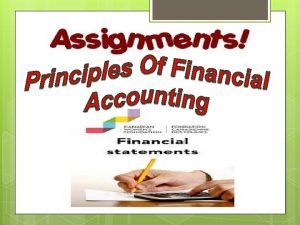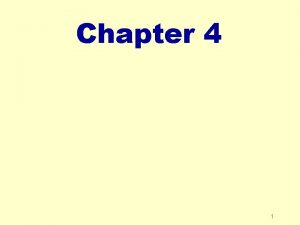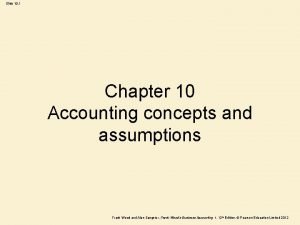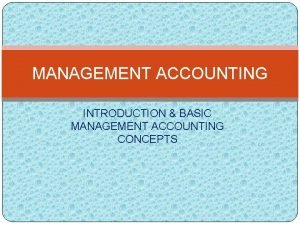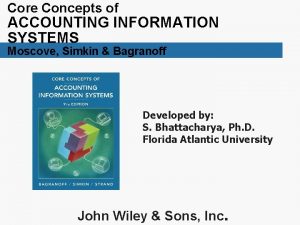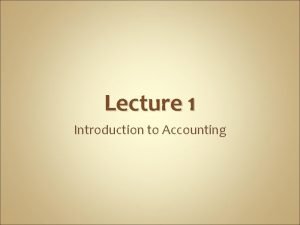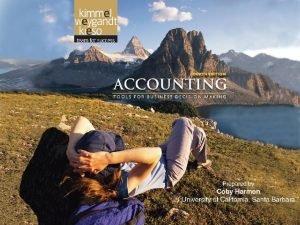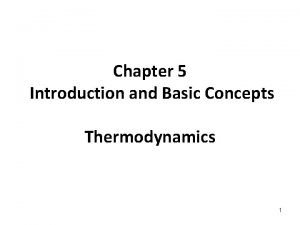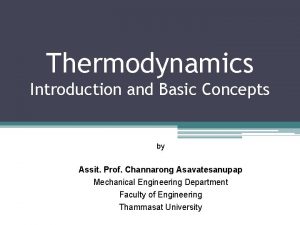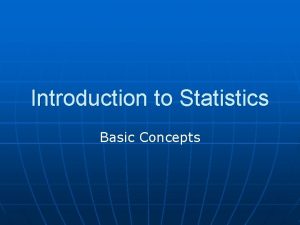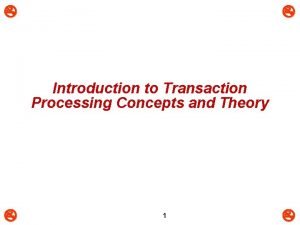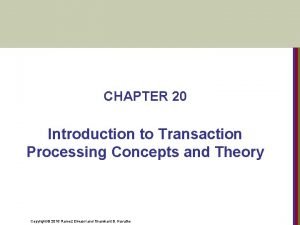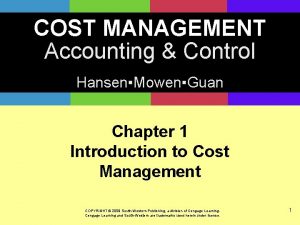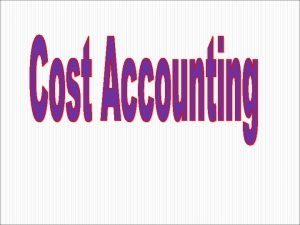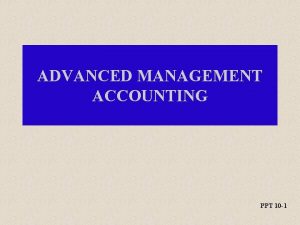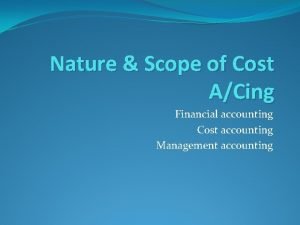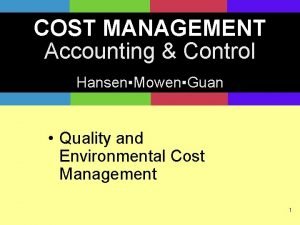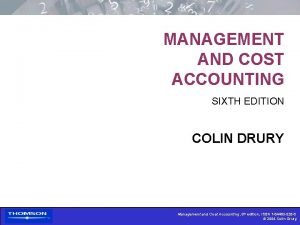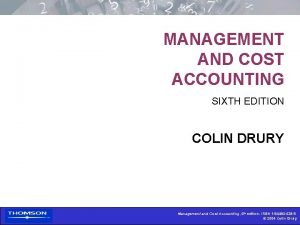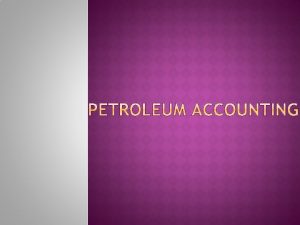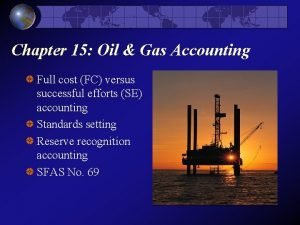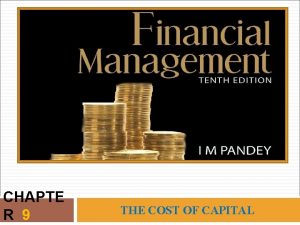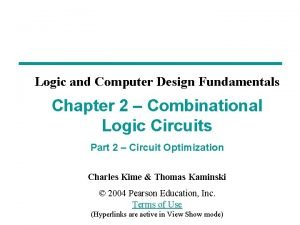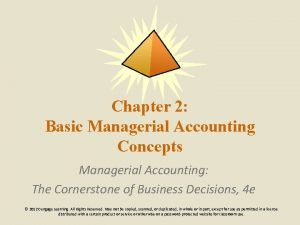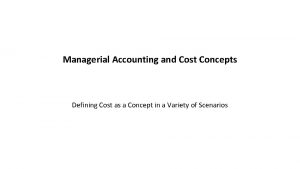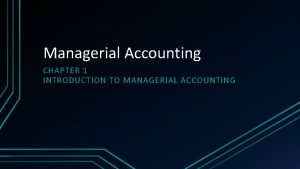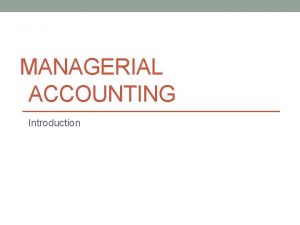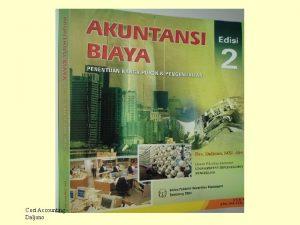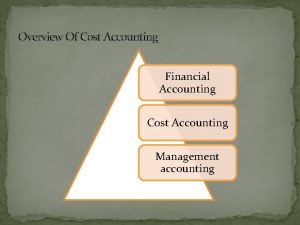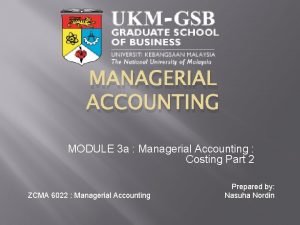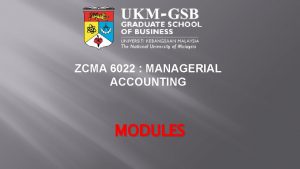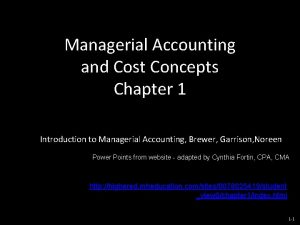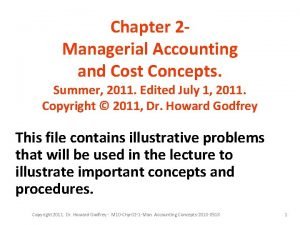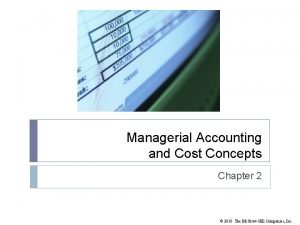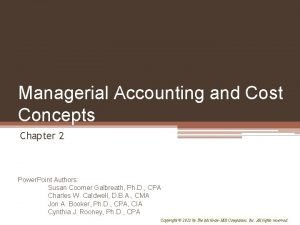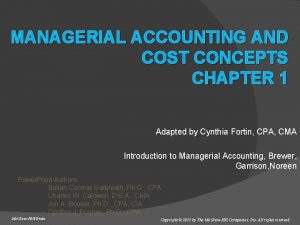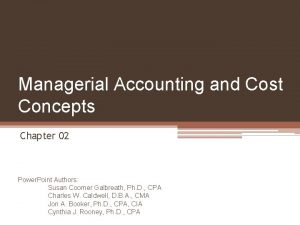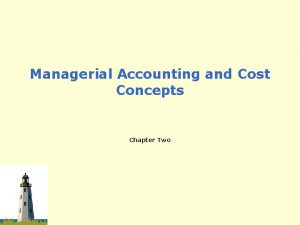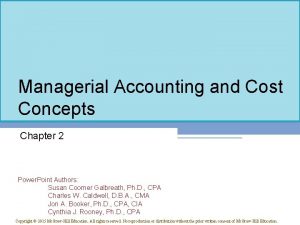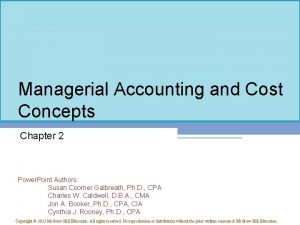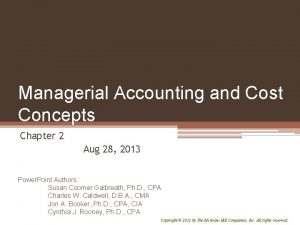Introduction to Managerial Accounting and Cost Concepts 1

























































































- Slides: 89

Introduction to Managerial Accounting and Cost Concepts 1

Managerial Accounting Basics Definition of Managerial Accounting A field of accounting that provides economic and financial information for managers and other internal users. Also called Management Accounting 2

Akuntansi Manajemen (Managerial Accounting) • Akuntansi manajemen adalah sistem pengakumulasian, pemrosesan, dan pengkomunikasian yang didesain untuk informasi pengambilan keputusan oleh pemakai internal • Akuntansi manajemen dikomunikasikan dengan laporan perusahaan internal dan tidak dibatasi oleh ketentuan yang membatasi akuntansi keuangan • Akuntansi manajemen hanya dibatasi oleh manfaat tidaknya informasi yang dihasilkan dan biaya yang dihabiskan untuk menghasilkan informasi tersebut 3

Management Accounting Information • The institute of Management Accountants has defined management accounting as: – A value-adding continuous improvement process of planning, designing, measuring and operating both nonfinancial information systems and financial information systems that guides management action, motivates behavior, and supports and creates the cultural values necessary to achieve an organization’s strategic, tactical and 4

Management Accounting Information – Management accounting provides both financial information and nonfinancial information – The role of management information supports strategic (planning), operational (operating) and control (performance evaluation) management decision making • In short, management accounting 5

Management Accounting Information • Examples of management accounting information include: – The reported expense of an operating department, such as the assembly department of an automobile plant or an electronics company – The costs of producing a product – The cost of delivering a service – The cost of performing an activity or business process – such as creating a customer invoice – The costs of serving a customer 6

Management Accounting Information • Management accounting also produces measures of the economic performance of decentralized operating units, such as: – Business units – Divisions – Departments • These measures help senior managers assess the performance of the company’s decentralized units 7

Management Accounting Information • Management accounting information is a key source of information for decision making, improvement, and control in organizations • Effective management accounting systems can create considerable value to today’s organizations by providing timely and accurate information about the activities required for their success 8

Review Question Managerial accounting: a. Pertains to the entity as a whole and is highly aggregated. b. Places emphasis on special-purpose information. c. Is limited to cost data. d. Is governed by generally accepted accounting principles. 9

Characteristics of Management Accounting Information Timeliness A Means to an End Identify Decision. Making Authority Measures of Efficiency and Effectiveness Oriented Toward Future 10

Managerial Accounting and Financial Accounting Managerial accounting provides information for managers of an organization who direct and control its operations. 11 Financial accounting provides information to stockholders, creditors and others who are outside the organization.

Management Functions Management’s activities and responsibilities can be classified into the following three broad functions: Planning Directing Controlling 12

Work of Management Planning Directing and Motivating Controlling 13

Management Functions Planning Look ahead and establish objectives such as – Maximize short-term profit Commit to environmental protection Key Objective: Add value to the business Value measured by trading price of stock and by potential selling price of the company 14

Management Functions Directing Coordinate diverse activities and human resources Implement planned objectives Provide incentives to motivate employees Hire and train employees including executives, managers, and supervisors 15

Management Functions Controlling Keep activities on track Determine whether goals are met Decide changes needed to get back on track May use an informal or formal system of evaluations Good decision making is the outcome of good judgment in planning, directing, and controlling. 16

The Three Management Functions • Questions asked: – What do I want to do? • Management functions: – Planning for the future (Strategic) – Planning for the – How can I do it? future (Operational) – Monitoring and – Am I getting it done? controlling the present – How well did I do it? – Evaluating the past 17

Planning and Control Cycle Formulating Long-and Short-Term Plans (Planning) Comparing Actual to Planned Performance (Controlling) Decision Making Measuring Performance (Controlling) 18 Begin Implementing the Plans (Directing and Motivating)

Review Question The management of an organization performs several broad functions. They are: a. Planning, directing, and selling. b. Directing, manufacturing, and controlling. c. Planning, manufacturing, and controlling. d. Planning, directing, and controlling. 19

Information about decision-making authority, for decision-making support, and for evaluating and rewarding decision-making performance. Information useful in assessing both the past performance and future directions of the enterprise and information from external and internal sources. Information useful to help the enterprise achieve its goal, objectives and mission. 20 Objectives of Managerial Reporting

Decision Making Attention Directing: Compare Actual Results to Expected Scorekeeping: Evaluate Organizational Performance Problem Solving: Assess Possible Courses of Action 21

A Model of the Decision-Making Process 22

Uses of Management Accounting Information • Planning for future periods – Strategic planning – Capital budgeting – Annual budgeting – Short-range planning • Organizing – using resources in the best way to achieve objectives • Directing – using daily information (e. g, costs, margins, sales etc) to oversee operations • Controlling – comparing actual results against what was planned; feedback in the form of performance reports is quite useful. 23

Organizations • An organization is a group of people joined together in seeking some common goal(s) or objective(s) • Organizations differ in their objectives; business firms seek to generate profits, while not-for-profit organizations do not. • Management of an organization will use strategic planning to help it achieve its objectives – strategic decisions about the products – Not-for-profit organizations will make similar 24

Organizations – Differences & Similarities • Two Major Types of Organizations – Profit-seeking • Corporations • Partnerships • Single proprietorships – Not-for-profit • Governmental organizations • Non-governmental organizations 25

Comparing Merchandising and Manufacturing Activities Merchandisers. . . – Buy finished goods – Sell finished goods Mega. Lo. Mart Manufacturers. . . – Buy raw materials. – Produce and sell finished goods 26

Managerial Cost Concepts Manufacturing Costs Manufacturing consists of activities to convert raw materials into finished goods. In contrast, a merchandising firm sells goods in the form in which they were bought. Categories of manufacturing costs include: 27

Manufacturing Costs Direct Materials Direct Labor The Product 28 Manufacturing Overhead

Materials Raw Materials Basic materials used in manufacturing Direct Materials Raw materials that can be physically and directly associated with the finished product 29

Direct Materials Those materials that become an integral part of the product and that can be conveniently traced directly to it. Example: A radio installed in an automobile 30

Indirect Materials Raw materials that cannot be easily associated with the finished product Not physically part of the finished product or they are an insignificant part of finished product in terms of cost Considered part of manufacturing overhead 31

Labor Direct Labor Work of factory employees that can be physically and directly associated with converting raw materials into finished goods Indirect Labor Work of factory employees that has no physical association with the finished product or for which it is impractical to trace to the goods produced 32

Direct Labor Those labor costs that can be easily traced to individual units of product. Example: Wages paid to automobile assembly workers 33

Manufacturing Overhead Costs that are indirectly associated with manufacturing the product Includes all manufacturing costs except direct materials and direct labor 34

Manufacturing Overhead Manufacturing costs that cannot be traced directly to specific units produced. Examples: Indirect labor and indirect materials Wages paid to employees who are not directly involved in production work. Examples: maintenance workers, janitors and security guards. 35 Materials used to support the production process. Examples: lubricants and cleaning supplies used in the automobile assembly plant.

Classifications of Costs Manufacturing costs are often classified as follows: Direct Material Direct Labor Prime Cost Manufacturing Overhead Conversio n Cost 36

Nonmanufacturing Costs Marketing and selling costs. . . – Costs necessary to get the order and deliver the product. Administrative costs. . . – All executive, organizational, and clerical costs. 37

Review Question Which of the following is not an element of manufacturing overhead? : a. Sales manager’s salary. b. Plant manager’s salary. c. Factory repairman’s wages. d. Product inspector’s salary. 38

Quick Check Which of the following costs would be considered manufacturing overhead at Boeing? (More than one answer may be correct. ) A. Depreciation on factory forklift trucks. B. Sales commissions. C. The cost of a flight recorder in a Boeing 767. D. The wages of a production shift supervisor. 39

Product Versus Period Costs Product Costs A necessary and integral part of producing the product Recorded as inventory when incurred Not an expense until the finished goods inventory is sold then cost of goods sold 40

Product Versus Period Costs Matched with revenue of a specific time period and charged to expense as incurred Non-manufacturing costs Deducted from revenues in period incurred to determine net income Includes all selling and administrative expenses 41

Product Costs Versus Period Costs Product costs include direct materials, direct labor, and manufacturing overhead. Inventory Cost of Good Sold Period costs are not included in product costs. They are expensed on the income statement. Expense Sale Balance Sheet Income Statement 42 Income Statement

Product Versus Period Costs 43

Quick Check Which of the following costs would be considered a period rather than a product cost in a manufacturing company? A. Manufacturing equipment depreciation. B. Property taxes on corporate headquarters. C. Direct materials costs. D. Electrical costs to light the production facility. 44

Chapter Review - Brief Exercise Indicate whether each of the following costs of an automobile manufacturer would be classified as direct materials, direct labor, or manufacturing overhead. ______ DM ______ DL ______ MO ______ DM ______ MO a. b. c. d. e. f. g. h. Windshield Engine Wages of assembly line worker Depreciation of factory machinery Factory machinery lubricants Tires Steering wheel Salary of painting supervisor 45

Chapter Review - Brief Exercise Identify whether each of the following costs should be classified as product costs or period costs. ______ Product ____________ Period ____________ Product a. b. c. d. e. f. Manufacturing overhead Selling expenses Administrative expenses Advertising expense Direct labor Direct material 46

Manufacturing Costs in Financial Statements Balance Sheet - Inventories Merchandising Company One category of inventory: Merchandise Inventory 47 Manufacturing Company May have three inventories: Raw Materials Work in Process Finished Goods

Balance Sheet Merchandiser Current assets – Cash – Receivables – Prepaid expenses – Merchandise inventory 48 Manufacturer Current Assets v Cash v Receivables v Prepaid Expenses v Inventories Raw Materials Work in Process Finished Goods

Balance Sheet Merchandiser Manufacturer Current assets – Cash – Receivables – Prepaid expenses – Merchandise inventory Partially complete products – some material, labor, or overhead has been added. 49 Current Assets v Cash v Receivables Materials waiting to be processed. v Prepaid Expenses v Inventories Raw Materials Work in Process Finished Goods Completed products awaiting sale.

Balance Sheet - Inventories 50

Manufacturing Costs in Financial Statements Income Statement The income statement for a manufacturer is similar to that of a merchandiser except for the cost of goods sold section. 51

Cost of Goods Sold Components Merchandiser versus Manufacturer 52

The Income Statement Cost of goods sold for manufacturers differs only slightly from cost of goods sold for merchandisers. 53

Determining the Cost of Goods Manufactured Work in Process – partially completed units of product Total Manufacturing Costs – sum of direct material costs, direct labor costs, and manufacturing overhead; all incurred in the current period 54

55

Manufacturing Cost Flows Balance Sheet Material. Costs Purchases Inventories Raw Materials Direct Labor Work in Process Manufacturing Overhead Selling and Administrative Income Statement Expenses Finished Goods Period Costs 56 Cost of Goods Sold Selling and Administrative

Review Question Direct Materials are a: Product Manufacturing Cost Overhead Period Cost a. Yes b. Yes No No c. Yes Yes d. No No 57 No No

Quick Check Which of the following transactions would immediately result in an expense? (There may be more than one correct answer. ) A. Work in process is completed. B. Finished goods are sold. C. Raw materials are placed into production. D. Administrative salaries are accrued and paid. 58

Inventory Flows Beginning balance $$ Available $$$$$ + Additions $$$ _ Withdrawals $$$ 59 = = Available $$$$$ Ending balance $$

Quick Check If your bank balance at the beginning of the month was $1, 000, you deposited $100 during the month, and withdrew $300 during the month, what would be the balance at the end of the month? $1, 000 + $100 = $1, 100 A. $1, 000. $1, 100 - $300 = $800 B. $ 800. C. $1, 200. D. $ 200. 60

Product Costs - A Closer Look Beginning inventory is the inventory carried over from the prior period. 61

Product Costs - A Closer Look As items are removed from raw materials inventory and placed into the production process, they are called direct materials. 62

Quick Check Beginning raw materials inventory was $32, 000. During the month, $276, 000 of raw material was purchased. A count at the end of the month revealed that $28, 000 of raw material was still present. What is the cost of direct material used? A. $276, 000 B. $272, 000 C. $280, 000 D. $ 2, 000 63

Product Costs - A Closer Look 64

Product Costs - A Closer Look Conversion costs are costs incurred to convert the direct material into a finished product. 65

Quick Check Direct materials used in production totaled $280, 000. Direct labor was $375, 000 and factory overhead was $180, 000. What were total manufacturing costs incurred for the month? A. $555, 000 B. $835, 000 C. $655, 000 D. Cannot be determined. 66

Product Costs - A Closer Look All manufacturing costs incurred during the period are added to the beginning balance of work in process. 67

Product Costs - A Closer Look Costs associated with the goods that are completed during the period are transferred to finished goods inventory. 68

Quick Check Beginning work in process was $125, 000. Manufacturing costs incurred for the month were $835, 000. There were $200, 000 of partially finished goods remaining in work in process inventory at the end of the month. What was the cost of goods manufactured during the month? A. $1, 160, 000 B. $ 910, 000 C. $ 760, 000 D. Cannot be determined. 69

Product Costs - A Closer Look 70

Quick Check Beginning finished goods inventory was $130, 000. The cost of goods manufactured for the month was $760, 000. And the ending finished goods inventory $130, 000 + $760, 000 = $890, 000 was $150, 000. What was the cost of $890, 000 - $150, 000 = $740, 000 goods sold for the month? A. $ 20, 000. B. $740, 000. C. $780, 000. D. $760, 000. 71

Cost Classifications for Predicting Cost Behavior How a cost will react to changes in the level of business activity. – Total variable costs change when activity changes. – Total fixed costs remain unchanged when activity changes. 72

Total Variable Cost Total Long Distance Telephone Bill Your total long distance telephone bill is based on how many minutes you talk. Minutes Talked 73

Variable Cost Per Unit Per Minute Telephone Charge The cost per long distance minute talked is constant. For example, 10 cents per minute. Minutes Talked 74

Total Fixed Cost Monthly Basic Telephone Bill Your monthly basic telephone bill probably does not change when you make more local calls. Number of Local Calls 75

Fixed Cost Per Unit Monthly Basic Telephone Bill per Local Call The average cost per local call decreases as more local calls are made. Number of Local Calls 76

Cost Classifications for Predicting Cost Behavior 77

Quick Check Which of the following costs would be variable with respect to the number of cones sold at a Baskins & Robbins shop? (There may be more than one correct answer. ) A. The cost of lighting the store. B. The wages of the store manager. C. The cost of ice cream. D. The cost of napkins for customers. 78

Quick Check Which of the following costs would be variable with respect to the number of people who buy a ticket for a show at a movie theater? (There may be more than one correct answer. ) A. The cost of renting the film. B. Royalties on ticket sales. C. Wage and salary costs of theater employees. D. The cost of cleaning up after the show. 79

Direct Costs and Indirect Costs Direct costs Indirect costs • Costs that can be • Costs cannot be easily and conveniently traced to a unit of product or to a unit of product other cost objective. or other cost object. • Examples: direct • Example: material and direct manufacturing labor overhead 80

Differential Costs and Revenues Costs and revenues that differ among alternatives. Example: You have a job paying $1, 500 per month in your hometown. You have a job offer in a neighboring city that pays $2, 000 per month. The commuting cost to the city is $300 per month. Differential revenue is: $2, 000 – $1, 500 = $500 Differential cost is: $300 81

Quick Check Suppose you are trying to decide whether to drive or take the train to Portland to attend a concert. You have ample cash to do either, but you don’t want to waste money needlessly. Is the cost of the pizza you ate last night relevant in this decision? In other words, should the cost of the pizza affect the decision of whether you drive or take the train to Portland? A. Yes, the cost of the pizza is relevant. B. No, the cost of 82 the pizza is not relevant.

Quick Check Suppose you are trying to decide whether to drive or take the train to Portland to attend a concert. You have ample cash to do either, but you don’t want to waste money needlessly. Is the cost of the train ticket relevant in this decision? In other words, should the cost of the train ticket affect the decision of whether you drive or take the train to Portland? A. Yes, the cost of the train ticket is relevant. B. No, the cost of the train ticket is not 83

Note • Every decision involves a choice from among at least two alternatives. • Only those costs and benefits that differ between alternatives (i. E. , Differential costs and benefits) are relevant in a decision. All other costs and benefits can and should be ignored. 84

Quick Check Suppose you are trying to decide whether to drive or take the train to Portland to attend a concert. You have ample cash to do either, but you don’t want to waste money needlessly. Is the annual cost of licensing your car relevant in this decision? A. Yes, the licensing cost is relevant. B. No, the licensing cost is not relevant. 85

Opportunity Costs The potential benefit that is given up when one alternative is selected over another. Example: If you were not attending college, you could be earning $15, 000 per year. Your opportunity cost of attending college for one year is $15, 000. 86

Sunk Costs Sunk costs cannot be changed by any decision. They are not differential costs and should be ignored when making decisions. Example: You bought an automobile that cost $10, 000 two years ago. The $10, 000 cost is sunk because whether you drive it, park it, trade it, or sell it, you cannot change the $10, 000 cost. 87

Quick Check Suppose that your car could be sold now for $5, 000. Is this a sunk cost? A. Yes, it is a sunk cost. B. No, it is not a sunk cost. 88

End of Week 89
 Managerial accounting cost concepts
Managerial accounting cost concepts Chapter 1 managerial accounting and cost concepts
Chapter 1 managerial accounting and cost concepts Chapter 1 managerial accounting and cost concepts
Chapter 1 managerial accounting and cost concepts Managerial accounting concepts and principles
Managerial accounting concepts and principles Managerial accounting chapter 2
Managerial accounting chapter 2 Management accounting chapter 1
Management accounting chapter 1 Introduction to managerial accounting ppt
Introduction to managerial accounting ppt Introduction of cost
Introduction of cost Concept of time perspective in managerial economics
Concept of time perspective in managerial economics Discounting principle in managerial economics
Discounting principle in managerial economics Methods of cost estimation in managerial economics
Methods of cost estimation in managerial economics Cost of goods manufactured formula
Cost of goods manufactured formula Accounting and the business environment
Accounting and the business environment Managerial accounting and the business environment
Managerial accounting and the business environment Financial and managerial accounting wild
Financial and managerial accounting wild Estimation of cost function in managerial economics
Estimation of cost function in managerial economics Scope of managerial accounting
Scope of managerial accounting Managerial accounting chapter 5 solutions
Managerial accounting chapter 5 solutions Managerial accounting chapter 13 solutions
Managerial accounting chapter 13 solutions Planning in managerial accounting
Planning in managerial accounting Managerial accounting chapter 2 solutions
Managerial accounting chapter 2 solutions Jiambalvo managerial accounting
Jiambalvo managerial accounting How to calculate cost of goods transferred out
How to calculate cost of goods transferred out Changing role of management accounting
Changing role of management accounting Managerial accounting chapter 7
Managerial accounting chapter 7 Chapter 1 managerial accounting
Chapter 1 managerial accounting Managerial accounting
Managerial accounting Managerial accounting james jiambalvo
Managerial accounting james jiambalvo Accounting scope
Accounting scope Manufacturing accounting basics
Manufacturing accounting basics Distinguishing features of managerial accounting
Distinguishing features of managerial accounting The institute of management accountants adopted the ______.
The institute of management accountants adopted the ______. Cost accumulation
Cost accumulation Dol managerial accounting
Dol managerial accounting Cost concepts and design economics
Cost concepts and design economics Cost terms concepts and classifications
Cost terms concepts and classifications Cost-benefit analysis concepts and practice
Cost-benefit analysis concepts and practice Basic concepts of accounting and finance
Basic concepts of accounting and finance What are the accounting concepts and conventions
What are the accounting concepts and conventions Part two analyzing transactions in a cash control system
Part two analyzing transactions in a cash control system Modifying principles of accounting
Modifying principles of accounting Cost accumulation and cost assignment
Cost accumulation and cost assignment Cost accumulation and cost assignment
Cost accumulation and cost assignment Cost accumulation and cost assignment
Cost accumulation and cost assignment What is a period cost on the income statement
What is a period cost on the income statement Cost control and cost reduction difference
Cost control and cost reduction difference Standard costing characteristics
Standard costing characteristics Distinguish between average cost and marginal cost
Distinguish between average cost and marginal cost Cost control and cost reduction difference
Cost control and cost reduction difference Job order cost system vs process cost system
Job order cost system vs process cost system Ordering cost and carrying cost
Ordering cost and carrying cost Trade offs and opportunity cost
Trade offs and opportunity cost Cost control and cost reduction project report
Cost control and cost reduction project report Cost control and cost reduction project report
Cost control and cost reduction project report Cost structure refers to the relative proportion of
Cost structure refers to the relative proportion of Accrual accounting concept
Accrual accounting concept 10 concepts of accounting
10 concepts of accounting Management accounting basics
Management accounting basics Core concepts of accounting information systems
Core concepts of accounting information systems Basic management accounting concepts
Basic management accounting concepts Partnership accounting basics
Partnership accounting basics Basics of accounting
Basics of accounting Slidetodoc
Slidetodoc Accrual accounting principles
Accrual accounting principles Introduction and basic concepts of thermodynamics
Introduction and basic concepts of thermodynamics Thermodynamics introduction and basic concepts
Thermodynamics introduction and basic concepts Introduction to statistics and some basic concepts
Introduction to statistics and some basic concepts Introduction to transaction processing concepts and theory
Introduction to transaction processing concepts and theory Introduction and mathematical concepts
Introduction and mathematical concepts Introduction and mathematical concepts
Introduction and mathematical concepts Transaction processing in dbms
Transaction processing in dbms Cost management accounting and control
Cost management accounting and control Controllable costs
Controllable costs Decentralization and transfer pricing ppt
Decentralization and transfer pricing ppt Scope of financial accounting
Scope of financial accounting Cost management accounting and control
Cost management accounting and control Social responsibility of management ppt
Social responsibility of management ppt Drury management and cost accounting
Drury management and cost accounting Drury c management and cost accounting
Drury c management and cost accounting Full cost method oil and gas
Full cost method oil and gas Full cost accounting oil and gas
Full cost accounting oil and gas Intermediate accounting chapter 1
Intermediate accounting chapter 1 Manufacturing cost vs non manufacturing cost
Manufacturing cost vs non manufacturing cost Job costing vs. process costing
Job costing vs. process costing Flotation cost in cost of equity
Flotation cost in cost of equity Controllable expenses examples
Controllable expenses examples Manufacturing cost vs non manufacturing cost
Manufacturing cost vs non manufacturing cost Material price variance
Material price variance Cost of equity
Cost of equity Literal cost gate input cost
Literal cost gate input cost
